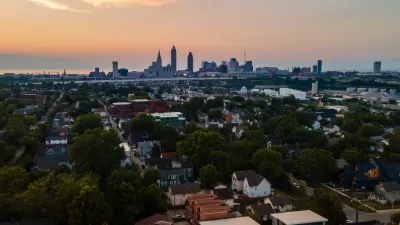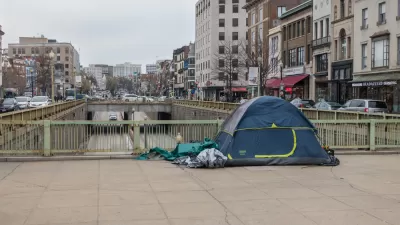A new study highlights the important role of emergency relief funding and eviction bans in stemming the rise of homelessness even as more families became housing-insecure.

Writing in Bloomberg CityLab, Kriston Capps outlines the concerns raised by a new analysis from the U.S. Department of Housing and Urban Development (HUD) that shows how eviction moratoriums and other emergency assistance programs launched during the pandemic helped prevent many Americans from falling into homelessness.
Officials describe this as an under-heralded success story of the pandemic emergency response. It’s also a warning about a still-urgent threat: In the wake of emergency relief efforts, homelessness is rising once again.
The study reveals that the number of households spending over 50 percent of their income on housing—the “worst-case housing needs”—hit a record 8.5 million household in 2021, yet sheltered homelessness decreased by 17 percent between 2019 and 2021. This is due to the “massive intervention” consisting of $47 billion in federal rental assistance and eviction moratoriums that kept many families with precarious housing situations in their homes.
Some key takeaways: “Pandemic interventions demonstrated that it’s possible to combat the routine use of evictions as a rent collection tool by combining legal aid with financial support.” Additionally, “Rapid rehousing, permanent supportive housing and other tools associated with the “housing first” model are the best options for dialing back homelessness, according to the analysis. And above all, homelessness is a housing problem, so building more rental housing at all levels of affordability is key to reducing the problems that lead to displacement.”
The study highlights an urgent warning: As pandemic relief programs end and housing instability remains a growing problem, “worst-case housing needs still represent an emergency.”
FULL STORY: Housing Instability Spiked During the Pandemic. Homelessness Didn’t.

Planetizen Federal Action Tracker
A weekly monitor of how Trump’s orders and actions are impacting planners and planning in America.

The Simple Legislative Tool Transforming Vacant Downtowns
In California, Michigan and Georgia, an easy win is bringing dollars — and delight — back to city centers.

San Francisco's School District Spent $105M To Build Affordable Housing for Teachers — And That's Just the Beginning
SFUSD joins a growing list of school districts using their land holdings to address housing affordability challenges faced by their own employees.

In More Metros Than You’d Think, Suburbs are Now More Expensive Than the City
If you're moving to the burbs to save on square footage, data shows you should think again.

The States Losing Rural Delivery Rooms at an Alarming Pace
In some states, as few as 9% of rural hospitals still deliver babies. As a result, rising pre-term births, no adequate pre-term care and "harrowing" close calls are a growing reality.

The Small South Asian Republic Going all in on EVs
Thanks to one simple policy change less than five years ago, 65% of new cars in this Himalayan country are now electric.
Urban Design for Planners 1: Software Tools
This six-course series explores essential urban design concepts using open source software and equips planners with the tools they need to participate fully in the urban design process.
Planning for Universal Design
Learn the tools for implementing Universal Design in planning regulations.
Smith Gee Studio
City of Charlotte
City of Camden Redevelopment Agency
City of Astoria
Transportation Research & Education Center (TREC) at Portland State University
US High Speed Rail Association
City of Camden Redevelopment Agency
Municipality of Princeton (NJ)





























